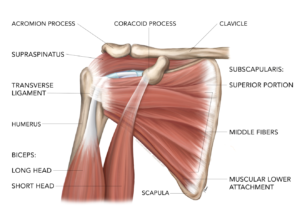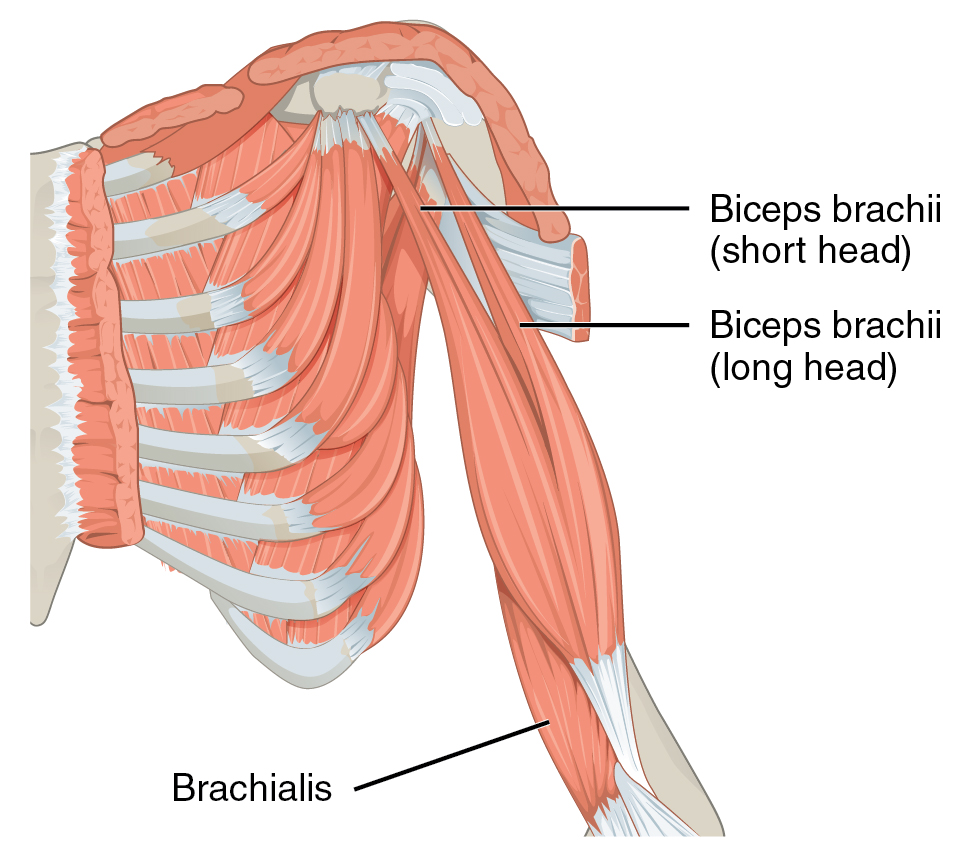 The biceps brachii is a large muscle of the upper arm. Originally called “musculus”, it got its name from the Latin for mouse, referring to the arch of a mouse’s back. It then gave its name back to all other muscles. The biceps is considered generally representative of strength across a variety of cultures.
The biceps brachii is a large muscle of the upper arm. Originally called “musculus”, it got its name from the Latin for mouse, referring to the arch of a mouse’s back. It then gave its name back to all other muscles. The biceps is considered generally representative of strength across a variety of cultures.
The biceps are a common source of pain in the front of the shoulder and occasionally the inside of the elbow. It is composed of two “heads” with slightly different attachments. The long head originates on the upper margin of the shoulder socket. The short head originates in the coracoid process on the front of the shoulder. Both heads proceed down the humerus, past the elbow, into the forearm and attach to the radius.
The actions of the biceps are complex. The primary function is to flex and rotate your forearm, moving it from pronation (palm down) to supination (palm up). It also flexes your arm at both the elbow and the shoulder and assists the rotator cuff in stabilizing your shoulder joint.
Trigger points in your biceps cause superficial pain in the front of your shoulder, sometimes extending down the front of your arm. This localized pain can be preliminary to biceps tendonitis and impingement syndrome. Pain may be present in the upper arm and inside of the elbow. You may have trouble keeping your arm extended when reaching behind your back.
Biceps brachii trigger points are typically activated from sudden or repetitive overload in activities with your arms outstretched, episodic elbow flexion load such as using an electric hedge trimmer, vigorous supination similar to a manual screwdriver, repetitive activities such as typing or playing the violin, and sudden stretching such as preventing a fall by reaching behind for a railing.
Corrective actions include trigger point pressure release, stretching, and avoiding activities that overload the muscle.
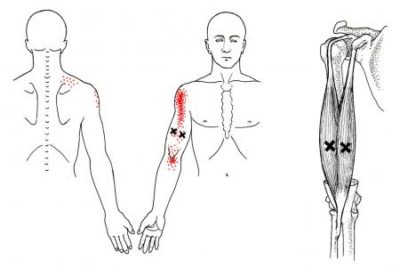 If you maintain a posture or activity that activates a trigger point in any muscle it will continue.
If you maintain a posture or activity that activates a trigger point in any muscle it will continue.
Trigger points can be activated anywhere in the biceps from unaccustomed eccentric loading, eccentric exercise in an unconditioned muscle, maximal or sub-maximal concentric loading. In a biceps curl, lifting the weight is a concentric load. A concentric load that is too large, moved repeatedly, or presents suddenly will overload the biceps. See the explanation of types of contractions at the bottom of this article.
Conversely, as you let the weight down and extend your arm in a biceps curl, you create an eccentric contraction against the load. If you did not unconsciously contract and gradually release your biceps, the weight would fall and your arm would extend suddenly. The release of the load in an eccentric contraction can stress the biceps as much or more than the concentric load, especially in a poorly conditioned muscle.
It is easy to understand why. If a weight is too heavy for the concentric contraction, we just won’t lift it. But a smaller weight requires constant eccentric contractions as we lift, move and lower it with control.
 Activities that can overload your biceps include repeated flexion at the elbow and shoulder and turning (supinating) the forearm. Occupations or activities that involve lifting objects with your arms extended put you at risk.
Activities that can overload your biceps include repeated flexion at the elbow and shoulder and turning (supinating) the forearm. Occupations or activities that involve lifting objects with your arms extended put you at risk. 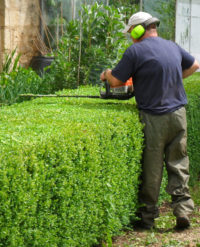 You may also have trouble after episodic elbow flexion loads such as using an electric hedge trimmer.
You may also have trouble after episodic elbow flexion loads such as using an electric hedge trimmer.
Electrical activity in the biceps increases directly with the speed of typing. You can also activate biceps trigger points with repetitive activities such as playing the violin and sudden stretching such as preventing a fall by reaching behind for a railing.
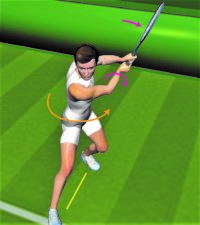 Less intuitive are insults come from vigorously rotating your forearm (supination) similar to a manual screwdriver or with the bracing arm of a two-handed backhand tennis stroke.
Less intuitive are insults come from vigorously rotating your forearm (supination) similar to a manual screwdriver or with the bracing arm of a two-handed backhand tennis stroke.
Placing any muscle in a shortened or lengthened position for an extended period of time can also activate trigger points in the muscle. This happens most often when we are sleeping. Prolonged flexion of your elbow, either during sleep or a surgical procedure, can activate trigger points in the biceps brachii.
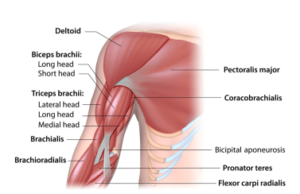 Myofascial self-care always starts with establishing a foundation of diaphragmatic breathing. Once you have taken a few moments to get in touch with your breath, we move on to self-compression.
Myofascial self-care always starts with establishing a foundation of diaphragmatic breathing. Once you have taken a few moments to get in touch with your breath, we move on to self-compression.
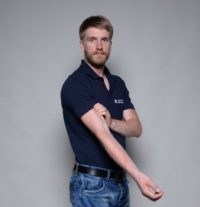 You can use self-pressure release for the biceps while seated, standing, or in side-lying positions.
You can use self-pressure release for the biceps while seated, standing, or in side-lying positions.
However, as you can see, compared to other muscles in your arm this muscle large and pretty hard to miss. Using your hand from the unaffected side, begin by using your fist to gently massage the bicep. Explore the muscle, note areas that are sorer, and bring your focus to them. To locate and compress specific trigger points, place your fingers along the outside of your humerus with your thumb on the inside, grabbing the muscle in a pincer grip. Find the tender spot and apply pressure for up to 30 seconds as pain decreases. You can do this three to five times.Repeat this compression in other positions as you flex your elbow.
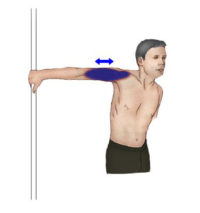
After completing self-compressions, move your arm through its range of motion and prepare to gently stretch your biceps.
You can use your breath to deepen the stretch. Begin with a generous inhale and as you exhale, gently stretch by rotating the body away from the doorframe. You can repeat this sequence three to five times, up to four times per day.
If you experience pain following pressure release and stretching, a cold pack may be helpful.
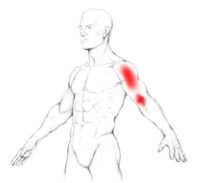 Pain in the front of the shoulder and arm, not deep in the joint, is typical of biceps trigger points. Pain is usually concentrated near the back of the shoulder. Pain in the crook of your elbow can also happen. Sometimes there is diffuse pain throughout the front side of the upper arm.
Pain in the front of the shoulder and arm, not deep in the joint, is typical of biceps trigger points. Pain is usually concentrated near the back of the shoulder. Pain in the crook of your elbow can also happen. Sometimes there is diffuse pain throughout the front side of the upper arm.
You may also have some problem difficulty in reaching behind your back if your arm is down and your elbow extended – you may have trouble putting on a coat without help.
 Movements like raising your arm above your shoulder with your elbow flexed or rotating your forearm may be painful and you may experience weakness from inhibition of the biceps. Snapping, popping or grating sounds may occur from the tendon of the long head when abducting the arm up and to the side. A sudden, painful catch in the shoulder when abducting the arm may be diagnosed as impingement syndrome. However, this is often secondary to trigger points in the biceps and may resolve with conservative treatment.
Movements like raising your arm above your shoulder with your elbow flexed or rotating your forearm may be painful and you may experience weakness from inhibition of the biceps. Snapping, popping or grating sounds may occur from the tendon of the long head when abducting the arm up and to the side. A sudden, painful catch in the shoulder when abducting the arm may be diagnosed as impingement syndrome. However, this is often secondary to trigger points in the biceps and may resolve with conservative treatment.
 Avoid repetitive actions that overload the muscle, such as lifting heavy objects with your arms extended. When necessary, modify your lift to keep your palms facing in rather than up.
Avoid repetitive actions that overload the muscle, such as lifting heavy objects with your arms extended. When necessary, modify your lift to keep your palms facing in rather than up.
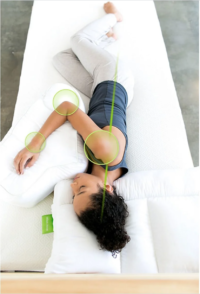 Biceps trigger points do not usually interfere with sleep, but improper sleeping positions can activate them. The tendency to curl the arm in an up is more pronounced for side sleepers. Consider sleeping on your back. It will help if you place a pillow inside your elbow to discourage elbow flexion, avoiding the prolonged shortening that can lead to pain.
Biceps trigger points do not usually interfere with sleep, but improper sleeping positions can activate them. The tendency to curl the arm in an up is more pronounced for side sleepers. Consider sleeping on your back. It will help if you place a pillow inside your elbow to discourage elbow flexion, avoiding the prolonged shortening that can lead to pain.
 You can also use this technique to support the painful arm when sleeping on your back or when sitting.
You can also use this technique to support the painful arm when sleeping on your back or when sitting.
Do not lie on your back with your arms extended up over your head. This will flex your shoulders and will also keep the biceps in a shortened position for an extended time.
In general, do not sleep on your stomach.
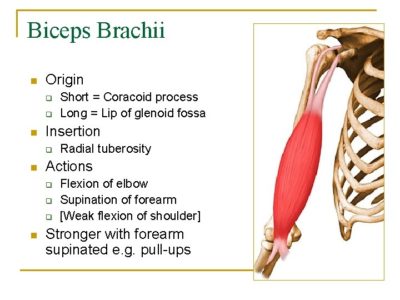 The biceps crosses both the shoulder and elbow, but its main function is at the elbow where it flexes the forearm and supinates the forearm. Both these movements are used when opening a bottle with a corkscrew: first biceps screws in the cork (rotating the forearm, supination), then it pulls the cork out (flexion).
The biceps crosses both the shoulder and elbow, but its main function is at the elbow where it flexes the forearm and supinates the forearm. Both these movements are used when opening a bottle with a corkscrew: first biceps screws in the cork (rotating the forearm, supination), then it pulls the cork out (flexion).
The biceps brachii work across three joints. The most important of these functions is to flex the elbow and supinate the forearm, but the biceps also flexes the shoulder forward (up) and assists in abduction and adduction of the arm at the shoulder joint. The long head of biceps also prevents the upward displacement of the head of the humerus, helping to to keep the ‘ball’ from popping up and out of the socket. The lateral portion of the long head of the biceps activates during elbow flexion, while the medial portion is preferentially activated during forearm supination.
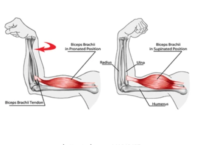 Proximal radioulnar joint of the elbow – The biceps brachii functions as a powerful supinator of the forearm, i.e. it turns the palm upwards. This action, which is aided by the supinator muscle, requires the humeroulnar joint (elbow) to be at least partially flexed. If the elbow is fully extended, the supinator muscle in the forearm becomes the prime mover. With the elbow flexed, the biceps becomes a powerful supinator of the forearm due to the attachment of the muscle deep in the forearm, at the radial tuberosity, on the opposite side of the bone from the supinator muscle. When the biceps is flexed, it effectively pulls the radius back into its neutral supinated position in concert with the supinator muscle.
Proximal radioulnar joint of the elbow – The biceps brachii functions as a powerful supinator of the forearm, i.e. it turns the palm upwards. This action, which is aided by the supinator muscle, requires the humeroulnar joint (elbow) to be at least partially flexed. If the elbow is fully extended, the supinator muscle in the forearm becomes the prime mover. With the elbow flexed, the biceps becomes a powerful supinator of the forearm due to the attachment of the muscle deep in the forearm, at the radial tuberosity, on the opposite side of the bone from the supinator muscle. When the biceps is flexed, it effectively pulls the radius back into its neutral supinated position in concert with the supinator muscle.
Humeroulnar joint of the elbow – The biceps brachii is an important flexor of the forearm, particularly when the forearm faces up. This action is performed when lifting an object, such as a bag of groceries, or when performing a biceps curl. 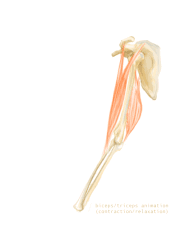 When the forearm is in pronation (facing down), the brachialis, brachioradialis, and supinator muscles flex the elbow, with little contribution from the biceps brachii. Note that regardless of forearm position, (supinated, pronated, or neutral) the force exerted by the biceps brachii remains the same. It is the relative contribution of the muscles that change. For instance, brachioradialis has a much greater variation in force depending on position than the biceps during concentric contractions. The biceps can only exert so much force, and as the forearm position changes, other muscles compensate.
When the forearm is in pronation (facing down), the brachialis, brachioradialis, and supinator muscles flex the elbow, with little contribution from the biceps brachii. Note that regardless of forearm position, (supinated, pronated, or neutral) the force exerted by the biceps brachii remains the same. It is the relative contribution of the muscles that change. For instance, brachioradialis has a much greater variation in force depending on position than the biceps during concentric contractions. The biceps can only exert so much force, and as the forearm position changes, other muscles compensate.
 Glenohumeral joint (shoulder joint) – Several weaker functions occur at the shoulder joint. The biceps brachii assists in forward flexion of the shoulder joint (bringing the arm forward and upwards). It also contributes to abduction (bringing the arm out to the side and up) when the arm is externally rotated. The short head of the biceps brachii also assists with horizontal adduction (bringing the arm across the body) when the arm is internally rotated.
Glenohumeral joint (shoulder joint) – Several weaker functions occur at the shoulder joint. The biceps brachii assists in forward flexion of the shoulder joint (bringing the arm forward and upwards). It also contributes to abduction (bringing the arm out to the side and up) when the arm is externally rotated. The short head of the biceps brachii also assists with horizontal adduction (bringing the arm across the body) when the arm is internally rotated.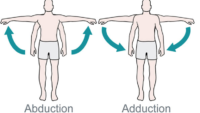
Finally, the short head of the biceps brachii, due to its attachment to the shoulder blade, assists with stabilization of the shoulder joint when a heavy weight is carried in the arm.
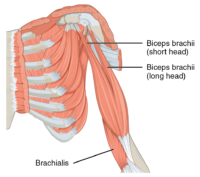 The biceps brachii is a large muscle on the front of the upper arm between the shoulder and the elbow. Both heads of the muscle arise on the shoulder blade and join to form a single muscle belly that is attached to the upper forearm.
The biceps brachii is a large muscle on the front of the upper arm between the shoulder and the elbow. Both heads of the muscle arise on the shoulder blade and join to form a single muscle belly that is attached to the upper forearm.
Structure
The biceps are one of three muscles in the front of the upper arm, along with the brachialis muscle and the coracobrachialis muscle. The biceps muscle has two heads, the short head, and the long head. From its origin on the glenoid (shoulder socket), the long head tendon passes through the shoulder joint and through the intertubercular groove of the humerus. Extending from its origin on the coracoid (the front bony part of the shoulder blade), the tendon of the short head runs as a conjoint tend adjacent to coracobrachialis. The biceps muscle crosses two joints, the shoulder joint, and the elbow joint.
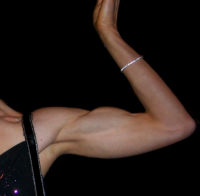 When well developed, the two heads of the biceps can be seen through the skin. Both heads of the biceps often join in the middle upper arm to form a single muscle mass near the insertion of the deltoid to form a common muscle belly. As the muscle extends down, the two heads rotate 90 degrees externally before inserting onto the radial tuberosity in the forearm. The short head inserts lower on the tuberosity while the long head inserts closer to the apex.
When well developed, the two heads of the biceps can be seen through the skin. Both heads of the biceps often join in the middle upper arm to form a single muscle mass near the insertion of the deltoid to form a common muscle belly. As the muscle extends down, the two heads rotate 90 degrees externally before inserting onto the radial tuberosity in the forearm. The short head inserts lower on the tuberosity while the long head inserts closer to the apex.
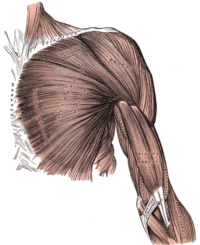 The bicipital aponeurosis (lacertus fibrosis), is a thick fascial band close to the musculotendinous junction of the biceps and radiates over and inserts onto the ulnar part of the forearm fascia.
The bicipital aponeurosis (lacertus fibrosis), is a thick fascial band close to the musculotendinous junction of the biceps and radiates over and inserts onto the ulnar part of the forearm fascia.
The tendon that attaches to the radial tuberosity is partially or completely surrounded by the bicipitoradial bursa, which ensures frictionless motion between the biceps tendon and the radius when pronating and supinating the forearm.
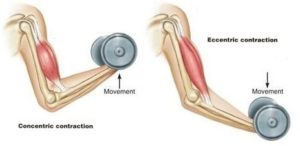 For example, in a biceps curl, you would use a concentric contraction of your biceps, coupled with an eccentric contraction of your triceps, to flex your elbow and push the weight up. As you lower the weight, eccentric contractions of your biceps are required to maintain control and prevent dropping the weight.
For example, in a biceps curl, you would use a concentric contraction of your biceps, coupled with an eccentric contraction of your triceps, to flex your elbow and push the weight up. As you lower the weight, eccentric contractions of your biceps are required to maintain control and prevent dropping the weight.
Isotonic Contractions
Isotonic contractions maintain constant tension in the muscle as the muscle changes length. This can occur only when a muscle’s maximal force of contraction exceeds the total load on the muscle. Isotonic muscle contractions can be either concentric (muscle shortens) or eccentric (muscle lengthens).Concentric Contractions
A concentric contraction is a type of muscle contraction in which the muscle shortens while generating force. This is typical of muscles that contract due to the sliding filament mechanism, and it occurs throughout the muscle. Such contractions also alter the angle of the joints to which the muscles are attached.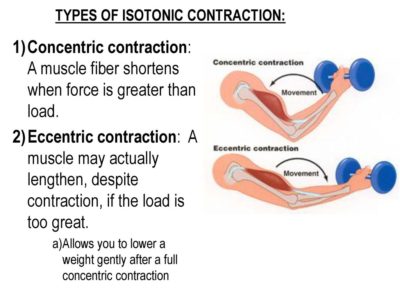 This occurs throughout the length of the muscle, generating force; causing the muscle to shorten and the angle of the joint to change. For instance, a concentric contraction of the biceps would cause the arm to bend at the elbow as the hand moves close to the shoulder (a biceps curl).
A concentric contraction of the triceps would change the angle of the joint in the opposite direction, straightening the arm and moving the hand away from the shoulder.
This occurs throughout the length of the muscle, generating force; causing the muscle to shorten and the angle of the joint to change. For instance, a concentric contraction of the biceps would cause the arm to bend at the elbow as the hand moves close to the shoulder (a biceps curl).
A concentric contraction of the triceps would change the angle of the joint in the opposite direction, straightening the arm and moving the hand away from the shoulder.
Eccentric Contractions
An eccentric contraction results in the lengthening of a muscle. These contractions decelerate muscles and joints (acting as “brakes” to concentric contractions) and can alter the position of the load force. During an eccentric contraction, the muscle lengthens while under tension due to an opposing force that is greater than the force generated by the muscle. However, rather than working to pull a joint in the direction of the muscle contraction, the muscle acts to decelerate the joint at the end of a movement or otherwise control the repositioning of a load. This can occur involuntarily (when attempting to move a weight too heavy for the muscle to lift) or voluntarily (when the muscle is “smoothing out” a movement). Strength training involving both eccentric and concentric contractions appears to increase muscular strength and joint stability more than training with concentric contractions alone.Isometric Contractions
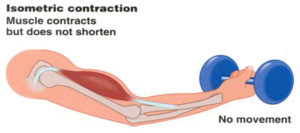 In contrast to isotonic contractions, isometric contractions generate force without changing the length of the muscle. This is typical of muscles found in the hands and forearm: the muscles do not change length, and joints are not moved, so force for grip is sufficient. An example is when the muscles of the hand and forearm grip an object; the joints of the hand do not move, but muscles generate sufficient force to prevent the object from being dropped.
For people with hypermobile joints, strength training can be a challenge. Tension stresses the connective tissues of the joint as force is transmitted through its range of motion. Isometric exercises can be ideal in these circumstances because there is minimal movement. This means that the joint is placed into vulnerable hyperextended positions under force.
In contrast to isotonic contractions, isometric contractions generate force without changing the length of the muscle. This is typical of muscles found in the hands and forearm: the muscles do not change length, and joints are not moved, so force for grip is sufficient. An example is when the muscles of the hand and forearm grip an object; the joints of the hand do not move, but muscles generate sufficient force to prevent the object from being dropped.
For people with hypermobile joints, strength training can be a challenge. Tension stresses the connective tissues of the joint as force is transmitted through its range of motion. Isometric exercises can be ideal in these circumstances because there is minimal movement. This means that the joint is placed into vulnerable hyperextended positions under force.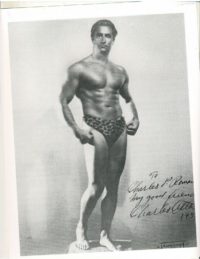 You can develop amazing strength without free weights, machines, or resistance bands.
One of the original bodybuilder gurus from the 1920s, Charles Atlas, based his workouts primarily on isometric exercises, eventually even trademarking a term for his exercise method that he called "Dynamic Tension."
If you have hypermobile joints you can strength train safely at home with isometric exercises.
You can develop amazing strength without free weights, machines, or resistance bands.
One of the original bodybuilder gurus from the 1920s, Charles Atlas, based his workouts primarily on isometric exercises, eventually even trademarking a term for his exercise method that he called "Dynamic Tension."
If you have hypermobile joints you can strength train safely at home with isometric exercises.

